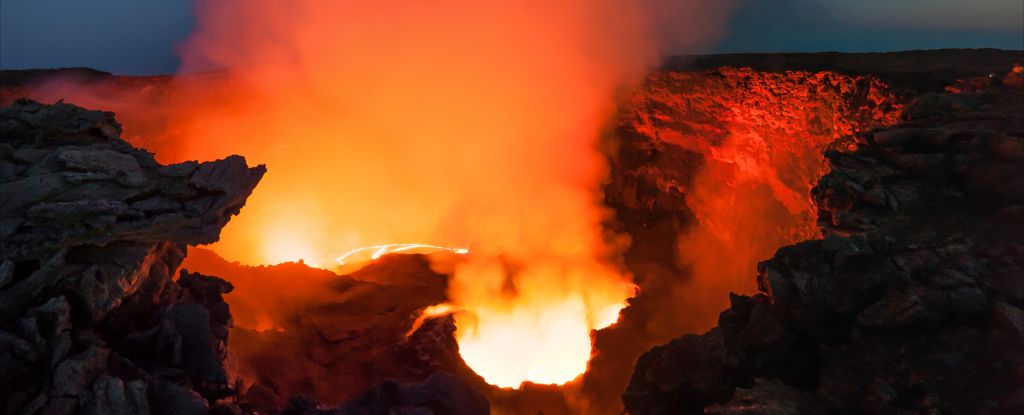
Earth Is Pulsing Beneath Africa Where The Crust Is Being Torn Apart
How did your country report this? Share your view in the comments.
Diverging Reports Breakdown
Earth Is Pulsing Beneath Africa Where The Crust Is Being Torn Apart
Mantle beneath Africa is not uniform or stationary – it pulses, scientists say. The pulses carry distinct chemical signatures. Eventually, the crust will become so thin here that the surface will drop below sea level. The finding could be used to inform future research into the activity that is continually remodeling our planet, say geologists in the UK, Italy and the U.S. It has “profound implications for how we interpret surface volcanism, earthquake activity, and the process of continental breakup,” says geophysicist Derek Keir of University of Southampton and the University of Florence in Italy.”We have found that the evolution of deep mantle upwellings is intimately tied to the motion of the plates above,” says Keir. “Follow-on research includes understanding how and at what rate mantle flow occurs beneath plates”
At the Afar triple junction under Ethiopia, where three tectonic plates meet, molten magma pounds the planet’s crust from below, scientists have discovered.
There, the continent is slowly being torn asunder in the early formation stages of a new ocean basin. By sampling the chemical signatures of volcanoes around this region, a team led by geologist Emma Watts of Swansea University in the UK hoped to learn more about this wild process.
“We found that the mantle beneath Afar is not uniform or stationary – it pulses, and these pulses carry distinct chemical signatures,” says Watts, who was at the University of Southampton in the UK when the research was conducted.
“These ascending pulses of partially molten mantle are channeled by the rifting plates above. That’s important for how we think about the interaction between Earth’s interior and its surface.”
Related: Earth’s Crust Is Dripping Under Midwest US, Scientists Discover
Our planet’s surface is in a constant state of renovation. The tectonic plates into which the planetary crust is divided aren’t fixed in position, but shift and collide and even slip underneath one another. The places at which they meet are usually hotspots of geological evolution, quite literally, rampant with volcanic activity that is reshaping the surface from below.
The Afar junction is the point at which the Arabian, Nubian, and Somalian plates meet, each departing in their own directions to leave a widening gap under the Afar Triangle. Eventually, the crust will become so thin here that the surface will drop below sea level, creating a new ocean basin off the Red Sea.
Scientists suspect that mantle upwelling is playing a role in this continental breakup process, but our understanding of how it works is limited. We can’t exactly just dig down to have a close look, so Watts and her colleagues went for the next best thing: looking at material that has been disgorged onto Earth’s surface from the mantle by way of volcano.
They collected 130 samples of volcanic rock from around the Afar region and the Main Ethiopian Rift, and conducted chemical analyses. They used these analyses combined with existing data to conduct advanced modeling to understand what’s going on with the activity under the Triangle.
The results showed distinct chemical bands or stripes that repeat across the rift system, delivered by a single, asymmetrical plume of material shaped by its environment and pushing upwards from the mantle.
“The chemical striping suggests the plume is pulsing, like a heartbeat,” says geologist Tom Gernon of the University of Southampton in the UK.
“These pulses appear to behave differently depending on the thickness of the plate, and how fast it’s pulling apart. In faster-spreading rifts like the Red Sea, the pulses travel more efficiently and regularly like a pulse through a narrow artery.”
If the team’s model is correct, it suggests that mantle plumes and upwellings can be shaped by the dynamics of the tectonic plates above them – a finding that could be used to inform future research into the activity that is continually remodeling our planet.
“We have found that the evolution of deep mantle upwellings is intimately tied to the motion of the plates above. This has profound implications for how we interpret surface volcanism, earthquake activity, and the process of continental breakup,” says geophysicist Derek Keir of the University of Southampton and the University of Florence in Italy.
“The work shows that deep mantle upwellings can flow beneath the base of tectonic plates and help to focus volcanic activity to where the tectonic plate is thinnest. Follow-on research includes understanding how and at what rate mantle flow occurs beneath plates.”
The research has been published in Nature Geoscience.
Source: https://www.sciencealert.com/earth-is-pulsing-beneath-africa-where-the-crust-is-being-torn-apart
